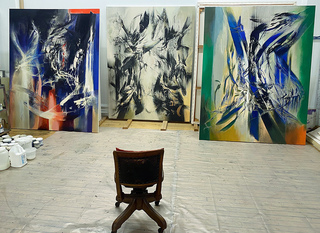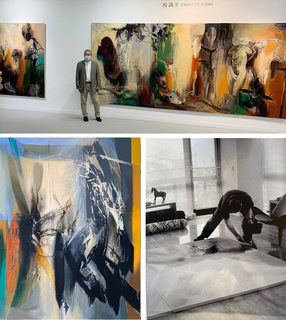

In addition to his creative achievements, Mr. Yang has a profound understanding of artistic concepts, and presents exciting insights on the dialectic and abstract creations of Eastern and Western cultures.
Dialects of Eastern and Western Cultures
Mr. Chihung Yang has lived in both Taiwan and the United States for many years. Yiart is curious about how Mr. Yang is able to find a balance and connection between these two cultures.
Chihung Yang: China has been discussing the issue of Eastern and Western culture since the May 4th Movement in 1919. When discussing this topic, we must look back 50 years. When I was in high school, the most discussed cultural debate was Li Ao, so I read some of his books. Li Ao had advocated for total westernization, stating that we should fully westernize, questioning “to what extent?”. Even syphilis.
In high school, seeing these conflicts rise between Eastern and Western cultures was indeed a shock. Returning to painting at the time, the Fifth Moon Group emphasized the need for the East and West, and the integration of the two cultures. At the time, young people within the intellectual, cultural, and artistic circles seemed to find it difficult to avoid encountering this cultural issue. After arriving in the United States, I gradually realized that the cultural conflict between East and West was not a problem at all. Paintings never need to be translated, only the writer, in particular, will study this aspect, because the text itself is representative of every culture and every race. Therefore in literature, the conflict between Eastern and Western culture will be very strong.
In the late 1960’s and 1970’s, it was impossible to create without addressing cultural issues. As an art creator, how should you respond to this problem? In fact, I had solved this problem before I went abroad. At the time, I couldn’t make a living solely on my creations, and during that time, there wasn’t a so-called art market in Taiwan, so I had to work for an advertising ad company. In order to have timely access to the most innovative western information, it was necessary to receive the latest information at the time, to serve consumers. Although there weren’t many people talking about globalization at the time, people were starting to talk about it. Since globalization, there weren’t many problems with the East and West. Now there are even less problems, and many things are misunderstandings and blind spots.
At the time, the Hollywood movie “Apartment Spring Light” (starring American actor Jack Lemmon), once popular in Taiwan, caused some discussion about high rise buildings, and how they were quite an original concept for the traditional society at the time. However, the emergence of apartments represent modern life, Western culture, and mass consumption culture. In order to resist the west, some conservatives questioned: “why do the Taiwanese need apartments?” and “why do Taiwanese artists have to paint tall buildings and glass curtains in order for it to be modern?”. Some local painters believed that they should paint buffaloes and rice fields.
Andrew Wyeth, for example, is regarded as an American realist painter, commonly known to create paintings of common life and people. Wyeth simply painted what he regarded as life, with a brush. However, some Taiwanese painters saw the cultural community promote rural movements and create related themes out of it. Therefore, painting water buffalo, rice fields, farmhouses, etc. was very popular at the time, which made people wonder why there were fixed themes for creating artworks.
In the 1960s, pop art became the most far-reaching art style, influencing popular fashion. Also, the so-called Western pop part was the face of the modern consumer society. For instance, Campbell Soup was a theme in Andy Warhol’s works, and pasta was a theme incorporated into James Rosenquist’s works. For Americans, this was considered home cooking. Mr. Yang laughed as he said this, stating that it’s just like how Taiwanese people eat braised pork rice, but no one actually paints it.
Modern Art Trend
As he talked about the historical context, Mr. Yang shared the book he wrote in the 1980s–– 《現代美術新潮》. Mr. Yang’s main reason for writing this book at the time was that he was exposed to many exhibitions in New York, and even discussions around the world. Therefore, Mr. Yang enthusiastically shared this information with readers in Taiwan. When introducing Western art, he also put in a great deal of effort to screen. For teachers, the process of investigating the production was important and should be approached cautiously. In the 1980’s, Mr. Yang was the first person to introduce Basquiat, Cindy Sherman, Julian Schnabel, Cy Twombly, and postmodernism in Chinese. At the time, the Asian art media didn’t even know about the influence that these foreign artists had on the history of art.
Mr. Yang’s writings also influenced a considerable number of Chinese youth at the time. When he was exhibiting his works at Pace Gallery, a reporter interviewed Chinese artist, Zhang Huan, asking him: “How do you become an artist?”. Since Zhang Huan grew up in China and didn’t know much about Western culture, he learned much about Western art through the works for Mr. Yang. After Chinese artist Chen Danqing read Mr. Yang’s book, he wrote a letter to the Central Academy of Fine Arts and invited Mr. Yang to give a speech. It is evident that Mr. Yang’s《現代美術新潮》has had a huge impact.
Photos © Chihung Yang

